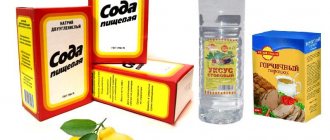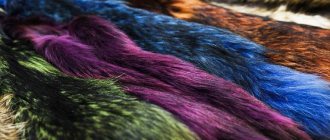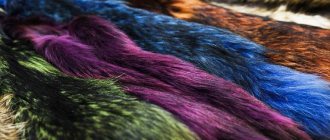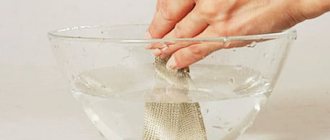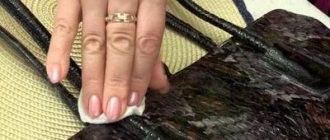At the end of the cold weather, fur clothes must be put away in the closet. But so that your favorite fur coat or hat does not lose its beautiful appearance, it needs to be cleaned. Many people do not know how to clean fur at home and take this problem to a dry cleaner.
But not everyone has the finances to afford this. That is why most women prefer to clean their fur items at home, using folk remedies. But how to clean a fur coat or blanket made of faux fur or natural sheepskin, mink, rabbit, etc.?
Ways to update the appearance of a fur product
If it is necessary to just slightly refresh a fur product, then there are several folk methods by which you can do this quickly and easily:
Using bran
- Heat the wheat bran on a baking sheet or frying pan.
- Distribute them over the fur item using rubbing movements.
- Leave the fur coat in this condition for 15–20 minutes.
- When the time is up, remove the bran and clean the fur.
- This product is more suitable for products made from rabbit or sheepskin.
Hot sand
- Place the fur coat on a flat surface.
- Apply sand to it.
- You need to rub it into your fur coat.
- Remove dirty sand from the product. Carry out the procedure several times until the sand is clean.
Typically this remedy is used for silver fox or arctic fox.
Shampoo for cats
- Dilute the shampoo in warm water and lather it.
- Apply to the fur coat with a soft bristle brush or sponge.
- It is necessary to rub the product into the pile of the product.
- Leave the fur item in this condition for 3–5 minutes.
- Rinse off the shampoo, being careful not to wet the skin to avoid cracking.
This product is excellent for products made from nutria, rabbit and chinchilla.
Birch sawdust
- Soak birch sawdust with turpentine, kerosene or gasoline.
- Distribute them throughout the product.
- Brush your fur coat.
Great for silver fox and rabbit.
Table vinegar and alcohol
- Add vodka and 9% acetic acid and vodka to the water; the ingredients must be mixed in equal quantities.
- Apply the resulting product to the fur using a soft product: a rag or sponge.
- Immediately after this, remove the solution from the product with a napkin.
More suitable for chinchilla and nutria.
When to clean your outerwear
Even the most expensive and high-quality thing can sooner or later become wrinkled, worn out, or dirty. Decoration made from animal fur is no exception. Such a product must be looked after carefully and scrupulously, and it must be cleaned or restored in a timely manner.
Signs that it’s time to tidy up the fur include the following factors:
- Manifestation of uneven color of the product.
- The presence of visible particles of debris between the villi.
- Plaque and dust contamination, as well as stains.
- Clumped fur.
- Loss of shine.
- Stale smell.
Tip : hang the fur coat on a hanger and direct the air flow from the hair dryer to the lint. If they scatter easily, then cleaning is not yet required. When the fur becomes sticky and crumpled, it’s time for special care.
We remove dirt from fur products
Quite often, on things made of natural fur, grease stains that are difficult to remove form. In order to get rid of them, you can go to a dry cleaner, but if you don’t have the money for that, then you can clean fur from stains at home:
Gasoline and starch
- Mix starch and gasoline, beat the mixture until mushy.
- Apply the resulting mixture to the resulting stain.
- Let the mixture dry.
- After this, clean the fur with a brush. If your fur coat has a long pile, then you need to brush according to the wool, if it is short - against it.
Liquid for washing woolen items
- Take 1 tbsp. spoon of wool detergent and dilute it in 250 ml of water.
- Apply the product to the grease stain and work it with a brush.
- Remove any remaining residue using a paper napkin.
Chalk
- Crush the chalk until it becomes powdery.
- Sprinkle it onto the stain.
- Wash your fur in a gentle manner. It is better to wash without using a washing machine.
- Remove any remaining product with a brush.
Salt and ammonia
- Dissolve 3–4 teaspoons of table salt and 1 teaspoon of ammonia in 0.5 ml of warm water.
- Apply the solution to the stain.
- Leave for 15 minutes.
- Remove the product thoroughly with a damp cloth or napkin.
Basic washing rules
A fur coat, especially from the skins of sable, astrakhan fur, chinchilla and ermine, is quite an expensive pleasure. It requires special storage and cleaning conditions.
There are dry cleaning methods adapted for specific types of fur:
- Mink. A solution of 9% vinegar, ethyl alcohol and water in equal parts is carefully applied with a brush in the direction of hair growth. The product is then wiped dry with a clean cloth. This method can be used to clean nutria and rabbit skins.
- The fur of muskrats, squirrels and seals can be cleaned with sand. To do this, the sand is washed well, then heated strongly and the contaminated areas are thoroughly sprinkled with it. If necessary, the procedure can be repeated. At the end, the product is shaken out well.
- Raccoon. An aqueous solution of salt and ethyl alcohol, in proportions of three to one per 500 grams of water, is applied to the dirt with a cotton pad. A clean product is wiped with a damp cloth.
- A wolf fur coat can be cleaned with a solution of alcohol and vinegar, similar to a mink.
- Arctic fox and light-colored sheepskin are cleaned with hot bran. They are heated in the microwave, carefully sprinkled onto the dirt and left to cool. Next, the remains are combed out with a brush.
Gasoline and starch, mixed to a paste, will remove difficult stains. But black and dark fur should not be cleaned this way.
Cleaning with animal shampoo will be universal; you can buy it at a pet store.
Dust and atmospheric pollution can be removed by laying the fur coat on a wet terry towel and gently tapping it.
Cleaning a fur coat
Light stains can be removed using the following dry cleaning methods. In case of loss of shine of the fur, noticeable dust and dirt in the down, and extensive stains, washing cannot be done without the help of washing.
There are a number of rules that, if followed, will help you wash a product without unpleasant consequences:
- Before starting cleaning procedures, be sure to test the product on an inconspicuous area;
- it is necessary to study the information on the label; perhaps the product should not be wetted;
- the water temperature during washing should not exceed forty degrees;
- Machine washable only for artificial fibers;
- Gels are recommended as detergents;
- during the cleaning process, it is necessary to carefully comb the pile, without active friction;
Having taken into account all the rules and tips, you can proceed directly to washing the product. Natural products need to be washed exclusively by hand; artificial ones can be washed in a machine.
ARTICLE FOR YOU
How to wash a medical gown so that it remains white, in the washing machine and by hand
Adding shine to fur
How to clean mink or arctic fox fur if it has lost its former shine? In order to return a fur coat or hat made of natural fur to its previous condition: rabbit, silver fox, chinchilla or sheepskin, you can use folk remedies that will solve your problems not only in, for example, how to clean the fur of an arctic fox, but also of any other animal.
Alcohol and ammonia
- Mix table vinegar and citric acid in a 1:1 ratio.
- Treat the fur.
- Let sit for 10 minutes.
- Remove the product thoroughly.
Fish fat
- To 1 liter of boiling water, add: 10–12 drops of ammonia, 100 grams of fish oil and 10 grams of dark laundry soap.
- Cool the solution to 30–35 degrees.
- Apply the solution to the fur.
- Leave for 5-10 minutes.
- Remove any remaining product.
How to remove yellowness
Folk remedies allow you to get rid of yellowish and grayish marks. These include:
- Lemon juice. It is used either alone or in combination with glycerin, vinegar, and ammonia. It is noteworthy that lemon juice does not need to be washed off the fur, which significantly speeds up the process.
- Soda. Suitable for dry cleaning at home. The powder is applied for half an hour and then combed out. Adding vinegar will improve efficiency. The mixture is quickly applied to the fur, dried and combed out.
- Salt. Coarse salt perfectly cleans a fur coat of yellowish and grayish stains, softens the fur and gets rid of unpleasant odors. Apply a thin layer of salt to the fur surface and rub it in carefully with your hands. After half an hour, the salt is shaken out and then thoroughly combed with a special brush.
How to clean faux fur
If your fur coat is not made from natural silver fox, chinchilla or mink hair, the question of how to clean faux fur does not disappear. When cleaning a blanket or faux fur coat, you must act carefully. There are several rules for caring for such things:
- If you store things incorrectly, they will become deformed and fade. If a fur coat or blanket has become dull, you can, of course, dye it, but it’s easy to do without it if you don’t: wring it out after washing, store it folded.
- When washing or cleaning, it is prohibited to use aggressive bleaching agents to avoid damage to the fur.
- Some faux fur contains a large amount of synthetics, which tends to deform during prolonged contact with water, so it is not recommended to wash such things.
What should you not do when cleaning your fur coat?
Cleaning a fur coat at home can either improve the condition of the fur, remove dirt, give it its original shine, or ruin its appearance. It is very important to properly clean your fur coat and not use dubious products. Let's consider several options that cannot be used when cleaning or storing fur coats:
After cleaning your fur coat, you should not dry it over a fire, radiators, or use a hairdryer. It should dry on its own, hung in a warm room by its hangers. As it dries, you need to shake it and comb it with a wide-toothed brush.
A fur coat made of faux or natural fur should be dried on hangers, this will help avoid deformation of the fur coat.
- It is strictly forbidden to iron any fur coat.
- There is no need to comb the fur unnecessarily.
- It is forbidden to clean fur with washing powder, which contains enzymes. Such powder can ruin the fur. It is better to use liquid powder.
- You should not clean your fur coat at home with dubious means.
- It is forbidden to store a fur coat in a plastic bag or rolled up.
- Fur coats should be cleaned at the end of the season, just before they are put away in the closet.
- It is recommended to take your fur coat out of the closet once a month and air it.
- Use special lavender-based moth repellents that can protect your item.
- Direct sunlight and temperatures above 25 degrees are considered harmful to a fur coat.
- Proper storage and cleaning of a fur coat will help increase the wear life of the fur coat and reduce the amount of dirt.
Proper cleaning and storage of a fur coat will help increase the wear life.
Cleaning a fur coat is quite a difficult task. Before doing it yourself, try cleaning a barely noticeable area of the fur coat. If you like the result, then you can clean other areas. If you have doubts about whether you can handle cleaning your favorite fur coat, it is better to take it to the dry cleaner. However, if you still decide to carry out the cleaning procedure yourself, we suggest watching the video instruction “How to clean a fur coat at home.”
How to wash faux fur
There are situations when simply cleaning the fur does not help to deal with stains, and then the question arises: is it possible to wash the fur? The answer is yes, but not all such products are recommended to be washed. Some blankets, hats and fur coats contain a large amount of synthetics, for which prolonged exposure to moisture has a detrimental effect, the item becomes dull and deformed.
You can paint a thing if it loses its color, but if it loses its shape, this is unlikely to help.
On fur products, there is always a label that says whether faux fur can be washed or not, and at what temperature. If it is allowed, then it must be carried out according to certain rules that say how to wash faux fur.
Things made of dark fur deserve special attention, because they tend to shed. So that you don’t have to look for a product that can be used to dye your favorite fur coat, it is enough to follow the basic rules for caring for fur items.
Going to dry cleaning
By entrusting your favorite item made of natural fur to dry cleaning professionals, you can quickly return the product to its original appearance and eliminate mistakes made during home cleaning.
Special equipment and detergents, competent actions of dry cleaning specialists with minimal risks of damage will clean the product from the following contaminants:
- dirty stains from melting snow and rain;
- traces of reagents and salts that are sprinkled on sidewalks during icy conditions;
- sweat stains, traces of cosmetics, the smell of perfume;
- tiny particles of dust from polluted urban air.
Experts recommend dry cleaning your fur items at least once a year, in the spring. The thing is that dry cleaning not only removes stains, but also prevents the appearance of moths - the main enemy of expensive natural fur.
The price for cleaning fur products is determined by many factors: length, complexity of cut, and the presence of additional accessories. On average, dry cleaning a product made from natural fur will cost 5,000 rubles.
Hand wash faux fur
There are certain rules that say how to wash faux fur by hand.
- Fill a large basin with water so that the fur fits into it without kinks. The liquid temperature should be no more than 40 degrees.
- Add detergent. When washing with powder, it must be stirred until completely dissolved so that there are no problems when washing the powder out of the fur.
- Immerse the item in the prepared product and leave for 20–30 minutes. If the fur is heavily soiled from the inside or outside, you can clean the fur with a brush, but it is not recommended to use excessive force.
- At the end of the time, the water must be drained and fresh water added, adding 1 teaspoon of vinegar to it to add shine. Rinse the item in this water, rinse with running water.
- The item cannot be wrung out; it must be laid out on a flat surface or placed on a hanger, the water will drain by itself.
- Fluff and comb the fur while drying.
Adviсe
Fur should not be dried in direct sunlight or near heating devices. Drying outdoors in the shade or in a well-ventilated area will help maintain the shine of the pile.- It is strictly forbidden to use dry abrasive powders, bleaches and stain removers when washing fur products.
- Fur should not be ironed (even from the reverse side).
- Fur products are never twisted. It is enough to wait until the water drains itself. You can speed up the process by smoothing your palm over the pile.
Cleaning faux fur
There are several ways to clean faux fur:
Dish soap and starch
- It is necessary to mix until smooth: starch , dish soap and washing powder . Portions of ingredients should be equal .
- Apply the mixture to the stain.
- The product must dry.
- Shake the item, and then treat it with a comb with infrequent teeth.
Fabric soaked in gasoline
- Soak the fabric in gasoline.
- Check in an inconspicuous place how the product affects the fur.
- Wipe the stain with this rag.
- Treat the area with a damp sponge.
How to clean white fur
Self-cleaning fur on light-colored items is only necessary if yellowness appears on the fur. Many women, faced with this problem, do not know how to clean white fur correctly. In order to remove the yellow spots that have formed on a fur coat or hat with a pompom, there are a lot of folk methods using improvised means:
Hydrogen peroxide
- Add 10 ml of hydrogen peroxide to 0.5 liters of water.
- Pour the resulting mixture into a spray bottle.
- Spray the product on the stain or the entire surface of the item, depending on the scale of the problem.
- Take the product outdoors.
- After it dries, comb the pile with a comb.
Alcohol and soda
- In 300 ml of water, add 5 ml of alcohol and 15 grams of soda.
- Soak a brush or sponge with the resulting solution.
- Treat the surface of the blanket or fur coat.
- Dry the item.
Alcohol and glycerin
- It is necessary to add 100 ml of vodka and 5 drops of glycerin to 0.5 liters.
- Pour the product into a spray bottle and use it to spray the mixture onto the pile.
- Treat the surface of the blanket or fur coat with a soft brush.
- Dry the item.
How to get rid of dust
Even in a well-closed case, a fur coat or vest can become dusty. Therefore, before storing a fur item for storage, and also before wearing it, freshen it.
Spread a damp white cotton sheet on the floor. Place the fur coat on top and beat it thoroughly, first on one side and then on the other. After that, hang it on a hanger and comb it.
If the fur is tangled and matted, spray the item with warm water from a spray bottle and let it dry. Then comb. The pile will fall into place. For the same purpose, you can carefully walk over the fur with a steamer.
How to clean a fur collar at home
Owners of beautiful fur coats or hats with a fluffy pompom: nutria, silver fox, chinchilla rabbit, mink, etc., are faced with the problem of how to clean a fur collar, because it is often the one that gets dirty the fastest. Before you start cleaning the fur on the collar, you need to determine the type of contamination. If there are greasy stains on the product, it is better to resort to dry cleaning.
For light-colored items, it is better to use dry cleaning.
Talc
- Unfasten the collar and lay it on a straight surface.
- Apply the product to the collar or hood.
- With dry hands, spread the powder over the entire area of the product.
- Leave for 15–20 minutes
- Shake off the product and let the collar or hood air out.
This cleaning method is suitable for light fur of a fox, arctic fox rabbit or mink.
How to properly care for a fur coat
Since a fur coat is not only an addition to your look, but also an element of style and taste, it should always look impeccable. Please be aware that there are multiple factors that can cause damage to this product, including:
- Wearing clothes in snow or rain, as a result, the fur sticks together, becomes unkempt and scanty.
- Inaccurate use of cosmetics or perfumes. Foundation, powder or lipstick can leave marks, for example on your collar. Apply any perfume or eau de toilette to clothes under a fur coat, otherwise the alcohol base will corrode the color of the product.
- Friction with bags, briefcases, clutches, belts, and jewelry is also harmful to fur. This leads to thinning of the fur fibers. In addition, some colored haberdashery items may fade and leave stains on a light-colored item.
- If a fur coat has not been aired or worn for a long time, and has been lying in the closet for several months, it can become an excellent “treat” for moths.
Compliance with the rules of wearing and storage will significantly extend the life of your favorite item.
Care according to species
The first thing you need to remember is the expiration date of the products. Furs from animals of different types are stored each in their own way, and for different amounts of time. For example, a rabbit will last no more than 5 years, but you can show off in an arctic fox fur coat for 7-8 years. The most durable are the beaver and the otter. They are worn until the age of 20.
For better preservation of any type of natural product, the following measures must be strictly observed.
- The item should be kept in a dark, dry place, it is best to first put on a clothing cover.
- It is also recommended to put a proven moth repellent there for the safety of the fur.
- To avoid damaging the fibers and wrinkles of your fur coat, hang it on a hanger. At the same time, do not squeeze it with other things - the product should hang freely.
- Before storing fur clothing in a closet for a long time, dry it in the open air, but keep it away from direct sunlight.
Arctic fox
- Before each trip outside, comb the fur from top to bottom with a stiff brush.
- After wet cleaning, dry the fur at room temperature by hanging it on a hanger. Never use a hair dryer or radiator for this.
- When fighting moths, try not to use sprays and mothballs. The smell is pungent and is strongly absorbed into the fur, making it extremely difficult to remove. It is recommended to purchase tablets or sachets.
- If you don’t know how to clean arctic fox fur and remove dirt at home, then it’s better to trust the professionals and have the product dry-cleaned.
Mink
- The collar of a mink coat requires special attention. Therefore, do not use lipstick or foundation to avoid staining the fur, otherwise it will be almost impossible to remove such stains. It is best to wear a scarf or scarf underneath.
- Mink should never be dried in the sun; it will fade and deteriorate irrevocably.
- The owner of a fur coat must take into account the delicacy of the product. Do not stand in lines to avoid rubbing against fur, do not sit on dirty benches and chairs. You should not carry bags or briefcases.
Rabbit, goat, nutria and wolf
- Such products are lighter in weight. This is due to the fact that they have a thin layer of flesh - skin. Therefore, furs from these animals cannot be worn in the snowy or rainy seasons.
- For this outerwear, dry clean only. Use starch or corn crumbs. Rub the composition into the fibers, then shake thoroughly.
- Be sure to store your fur coat in a case with a small amount of moth repellent added to it, otherwise in winter you will find a thing that has been eaten by insects.
Otter, beaver and mole
The fur of these animals is considered not only the strongest and most durable, but also the most frost-resistant.
- Due to the many positive characteristics and long-lasting wear, natural otter and beaver products are very expensive, but you pay a pretty penny for high quality and durability.
- If you wet the fur, then it is unpretentious in drying. It is enough to place the product near the battery, hanging it, for example, on a chair. Then comb the fibers.
- Over time, things made from beaver or mole may become salty. Use a solution of alcohol and warm water in a ratio of 1:10 to wipe the fur, then dry and comb the same way.
How to wash a dark fur collar
Dark things tend to fade and so that you don’t have to think about how to paint the item later, it is better to clean the collar or pom-pom on the hat using the right products:
- Dissolve 1 tbsp in a liter of water. spoon of shampoo.
- Using a sponge, apply the product to the pile of your collar.
- After 15 minutes, rinse the item in warm water.
- Lay the collar on the fabric.
- Brush the collar while drying.
The product is excellent for hoods and collars made of dark fur: silver fox and chinchilla. The mixture will retain the color and you won’t have to think about how to dye your collar or hat with a pompom.
Stages in tanning hides
Degreasing
Before processing the skin of an animal, the workpiece must be degreased in order to remove any remaining meat, fat deposits, and blood from the flesh. If you skip degreasing, the leather will lose elasticity, become brittle and brittle, and not suitable for dressing. And a product made from such skin will become unwearable very quickly.
Washing and unwinding
After degreasing, the workpiece must be thoroughly rinsed to remove chemicals and traces of blood and fat. The unwinding process resembles canning and is carried out in a saline solution or in a solution of special antiseptics. After proper washing and unwinding, the skin acquires the necessary steamed state, which can be easily determined by sufficient water content and the restored properties of the elements of the dermis.
Pickling and laying
The most important step is pickling or pickling. The subsequent ductility and elasticity of the skin depends on it. Most often, table salt and one of the organic acids are used for pickling. After pickling, the skin must be cured. For curing, the workpiece is removed from the pickle solution, wrung out, rolled up so that the flesh is inside and left for at least ten hours.
Tanning and fatliquoring
After fermentation comes the turn of tanning. The process is necessary to consolidate the effect of separating leather fibers, as well as to make the workpiece more resistant to external factors: heat, humidity, various enzymes and chemicals. Most often, tanning occurs in a solution containing chromium salts. Fatliquoring is carried out after tanning and a variety of compositions are used for it. However, each of them must contain fat of animal origin. Most often they use pork or lamb fat, but some tanners prefer to work with fish and even bone fat.
Storage after fattening should take at least eighteen hours.
Breakdown and fleshing
Before you start stripping the leather, a breakdown is necessary. It is at this stage that the curing of the skin as such ends. The subsequent stages are more mechanical. The purpose of breaking is to process the flesh until it is soft and elastic. After all the chemical solutions, the leather fibers became pliable, but retained their strength. Breaking involves repeatedly pulling the skin with very sharp bending through a thin yard, a board, a blunt braid, a metal bracket or fitting, or a clothesline. The thinner the item, the better. If the breakdown was carried out correctly, the flesh becomes whitish-cream in color, and the fur becomes shiny and fluffy.
How to wash a fur collar with long pile
Fur items with long pile need to be washed with greater care; in no case should you use detergents containing chlorine
- Dilute soap solution in water.
- Dip the item into the liquid.
- Leave the collar in the water for half an hour.
- At the end of the time, rinse the product.
- Dry the collar; it needs to be combed from time to time.
Knowing these basic folk recipes, you won’t have to look for advice on how to wash fur or how to dye it if it has faded during wear.





